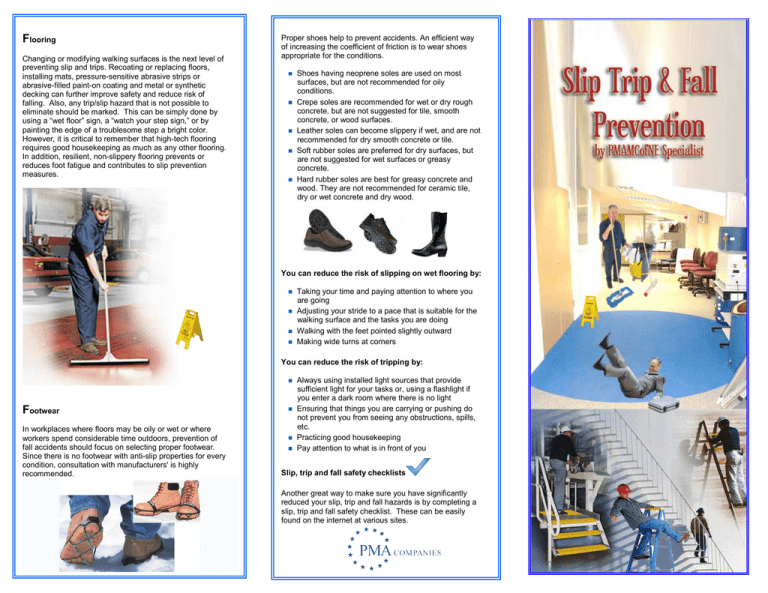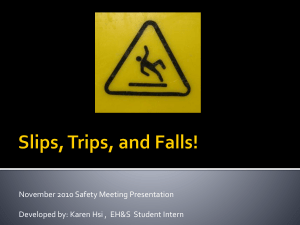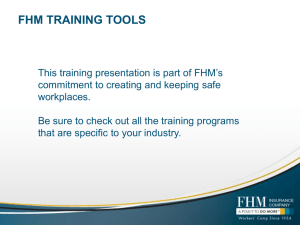Flooring
advertisement

Flooring Changing or modifying walking surfaces is the next level of preventing slip and trips. Recoating or replacing floors, installing mats, pressure-sensitive abrasive strips or abrasive-filled paint-on coating and metal or synthetic decking can further improve safety and reduce risk of falling. Also, any trip/slip hazard that is not possible to eliminate should be marked. This can be simply done by using a “wet floor” sign, a “watch your step sign,” or by painting the edge of a troublesome step a bright color. However, it is critical to remember that high-tech flooring requires good housekeeping as much as any other flooring. In addition, resilient, non-slippery flooring prevents or reduces foot fatigue and contributes to slip prevention measures. Proper shoes help to prevent accidents. An efficient way of increasing the coefficient of friction is to wear shoes appropriate for the conditions. Shoes having neoprene soles are used on most surfaces, but are not recommended for oily conditions. Crepe soles are recommended for wet or dry rough concrete, but are not suggested for tile, smooth concrete, or wood surfaces. Leather soles can become slippery if wet, and are not recommended for dry smooth concrete or tile. Soft rubber soles are preferred for dry surfaces, but are not suggested for wet surfaces or greasy concrete. Hard rubber soles are best for greasy concrete and wood. They are not recommended for ceramic tile, dry or wet concrete and dry wood. You can reduce the risk of slipping on wet flooring by: Taking your time and paying attention to where you are going Adjusting your stride to a pace that is suitable for the walking surface and the tasks you are doing Walking with the feet pointed slightly outward Making wide turns at corners You can reduce the risk of tripping by: Footwear In workplaces where floors may be oily or wet or where workers spend considerable time outdoors, prevention of fall accidents should focus on selecting proper footwear. Since there is no footwear with anti-slip properties for every condition, consultation with manufacturers' is highly recommended. Always using installed light sources that provide sufficient light for your tasks or, using a flashlight if you enter a dark room where there is no light Ensuring that things you are carrying or pushing do not prevent you from seeing any obstructions, spills, etc. Practicing good housekeeping Pay attention to what is in front of you Slip, trip and fall safety checklists Another great way to make sure you have significantly reduced your slip, trip and fall hazards is by completing a slip, trip and fall safety checklist. These can be easily found on the internet at various sites. Most years slips, trips, and falls result in somewhere between 15 percent and 20 percent of all nonfatal workplace injuries; the highest frequency of injury of any single regulated activity. In one recent year, 803 workers died as a result of workplace falls. Every 35 minutes an older adult dies as the result of a fall (National Resource on Aging and Injury). The National Safety Council states that there are over 9 million disabling slip/fall injuries requiring hospitalization every year (that’s about 25,000 per day). More than 300,000 are “disabling” injuries. The Bureau of Labor statistics shows that 104 million lost workdays per year is due to slip/fall injures. This represents 65% of all employee-hours lost, and is one of the reasons why Workers’ Compensation rates are increasing approximately 30% every year. Healthcare According to the U.S. Bureau of Labor Statistics [2009], the incidence rate of lost-workday injuries from slips, trips, and falls (STFs) on the same level in hospitals was 38.2 per 10,000 employees, which was 90% greater than the average rate for all other private industries combined (20.1 per 10,000 employees). STFs as a whole are the second most common cause of lost-workday injuries in hospitals. 3 Basic steps to avoid slips, trips, and falls: Slips Slips occur where there is too little friction or traction between the footwear and the walking surface. Slips can cause you to loose your balance and eventually fall. Common causes of slips are: Wet or oily surfaces Occasional spills Weather hazards Loose, unanchored rugs or mats Flooring or other walking with poor traction Trips Trips occur when your foot collides (strikes, hits) an object causing you to lose your balance and eventually fall. Common causes of tripping are: In all, slips, trips and falls make up 25% of lostworkday injuries in hospitals, according to the report. They rank second in frequency behind overexertion (38%) and ahead of contact injuries (14%). Slips, trips and falls were significantly more likely than other types of injuries to result in fractures and multiple injuries. Understand how fall accidents happen Identify the trouble areas Eliminate or minimize hazards of falling. Obstructed view (as when carrying an object) Poor lighting Clutter in your way Wrinkled carpeting Uncovered cables Bottom drawers not being closed Uneven (steps, thresholds) walking surfaces Prevention of Falls due to Slips and Trips Both slips and trips result from some a kind of unintended or unexpected change in the contact between the feet and the ground or walking surface. This shows that good housekeeping, quality of walking surfaces (flooring), selection of proper footwear, and appropriate pace of walking are critical for preventing fall accidents. Housekeeping is not just cleanliness. It includes keeping work areas neat and orderly; maintaining halls and floors free of slip and trip hazards; and removing of waste materials (e.g., paper, cardboard) and other hazards from work areas. It also requires paying attention to important details such as the layout of the whole workplace, aisle marking, the adequacy of storage facilities, and maintenance. Effective housekeeping is an ongoing operation: it is not a hit-and-miss cleanup done occasionally. Housekeeping Good housekeeping is the first and the most important (fundamental) level of preventing falls due to slips and trips. It includes: Cleaning all spills immediately Marking spills and wet areas Mopping or sweeping debris from floors Removing obstacles from walkways and always keeping them free of clutter Securing (tacking, taping, etc.) mats, rugs and carpets that do not lay flat Always closing file cabinet or storage drawers Covering cables that cross walkways Keeping working areas and walkways well lit Replacing used light bulbs and faulty switches Researchers analyzed workers’ compensation injury claims from acute-care hospitals and found that slips, trips, and falls most commonly resulted in injuries to the lower extremities: Injuries to the knees, ankles and feet made up 44.9% of cases. The nature of injury most often was sprains, strains, dislocations and tears, representing 48.3% of cases. SOURCES: ISSA/OSHA Alliance, CCOHS, UNM, NASD, DHHS NOTE: Without good housekeeping practices, any other preventive measures such as installation of sophisticated flooring, specialty footwear or training on techniques of walking and safe falling will never be fully effective.



